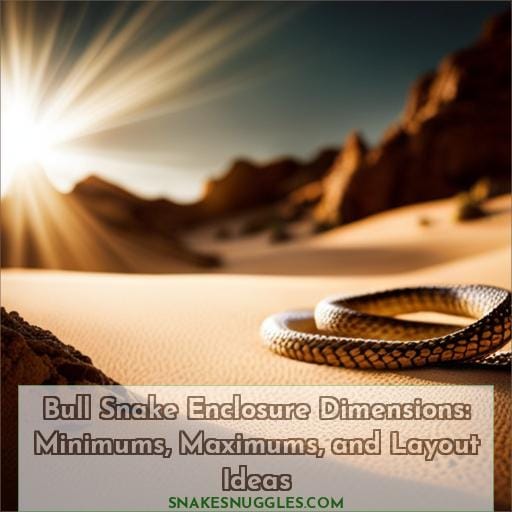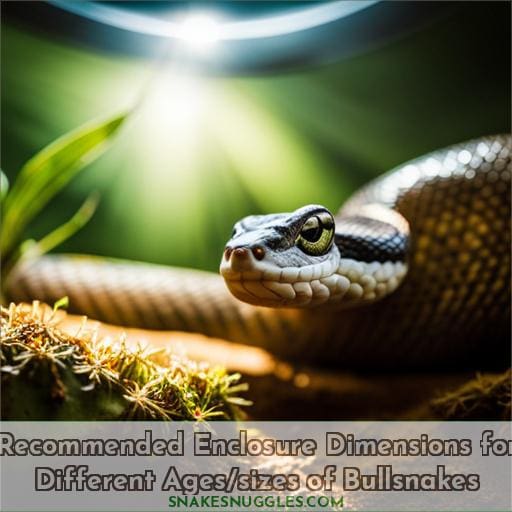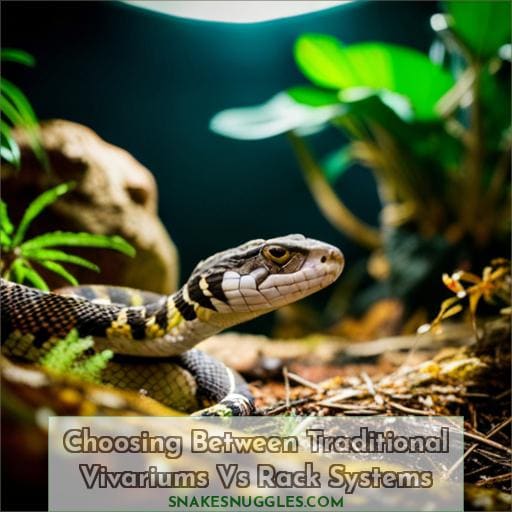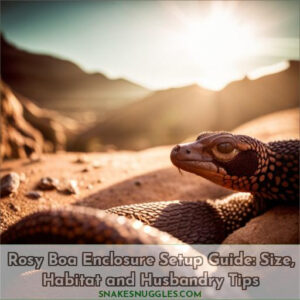This site is supported by our readers. We may earn a commission, at no cost to you, if you purchase through links.
 Truth be told, figuring out bull snake enclosure dimensions takes some noodling.
Truth be told, figuring out bull snake enclosure dimensions takes some noodling.
We’ll spill the beans on recommended minimums and maximums for these colubrids’ cages based on age and size.
From traditional vivariums to rack systems, we’ll explore layout ideas to give your bull snake a home where it can really stretch out.
With the right info, you can set up quality housing so your scaly friend will thrive.
Table Of Contents
- Key Takeaways
- Recommended Enclosure Dimensions for Different Ages/sizes of Bullsnakes
- Minimum and Maximum Enclosure Size Guidelines
- Choosing Between Traditional Vivariums Vs Rack Systems
- Considerations for Height Vs Floor Space
- How to Scale Up the Enclosure Size as the Snake Grows
- Frequently Asked Questions (FAQs)
- What are some good budget-friendly enclosure options for a baby or juvenile bullsnake?
- Should I use a screen top or solid top on the enclosure? What are the pros and cons of each?
- How can I make the enclosure feel more secure and reduce stress for a newly acquired bullsnake?
- What types of materials should I avoid using inside the bullsnake enclosure?
- How often should I completely replace the substrate in the enclosure?
- Conclusion
Key Takeaways
- Floor space is a higher priority than enclosure height. Aim for wide floor plans to accommodate a terrestrial species.
- Adult bull snakes need a minimum 48 x 24 inch enclosure. Provide ample floor space as they grow.
- Incorporate vertical elements like branches, textured backgrounds, elevated hides, and perches to allow climbing and enrichment.
- Substrate, hides, heating, and lighting should suit the specific needs of bull snakes.
Recommended Enclosure Dimensions for Different Ages/sizes of Bullsnakes
You should provide hatchling bullsnakes with a 20-gallon tank that has a footprint of at least 18×18 inches.
As the snake grows over its first year, plan to transition it to a larger 30-gallon enclosure with a 24×18 inch footprint once it reaches 18-24 inches long.
Within the first two years, it will likely outgrow that size and require an adult enclosure of at least 48×24 inches (4ft x 2ft).
The actual dimensions can vary depending on whether you use a rack system or traditional display vivarium.
Focus on providing adequate floor space rather than height, but incorporate some climbing branches.
As the snake continues growing, scale up the floor space while allowing room for hides, water bowls, and other essential elements.
Prioritize floor space over height.
Minimum and Maximum Enclosure Size Guidelines
Rack Systems Pros and Cons:
- Space-efficient: Multiple enclosures in a compact area.
- Easier maintenance: Centralized access to enclosures.
- Less visual appeal: Not as aesthetically pleasing as display vivariums.
- Limited customization: Less flexibility for individual enclosure setups.
Display Vivariums Pros and Cons:
- Visually appealing: Provide a more natural habitat for the animal.
- More customization: Greater flexibility for individual enclosure setups.
- More space for the animal: Can accommodate larger animals.
- More maintenance: Requires more time and effort to clean and maintain.
Substrates:
- Variety of options: Sand, soil, bark, coconut fiber, etc.
- Consider animal needs: Substrate should be appropriate for the species.
- Maintenance: Some substrates require more frequent cleaning than others.
Hide Options:
- Importance: Provides a sense of security for the animal.
- Variety of options: Caves, logs, plants, etc.
- Consider animal needs: Hide should be appropriate for the species’ size and behavior.
Heating/Lighting Setups:
- Importance: Regulates temperature and provides necessary light.
- Variety of options: Heat lamps, heat mats, UVB lights, etc.
- Consider animal needs: Heating and lighting should be appropriate for the species.
Traditional Vivariums:
- Single enclosure for one animal.
- More visually appealing: Provides a more natural habitat for the animal.
- More space for the animal: Can accommodate larger animals.
- More maintenance: Requires more time and effort to clean and maintain.
Rack Systems:
- Multiple enclosures in a compact area.
- Space-efficient: Easier maintenance: Centralized access to enclosures.
- Less visual appeal: Not as aesthetically pleasing as display vivariums.
- Limited customization: Less flexibility for individual enclosure setups.
Display vs Rack Enclosures:
- Choice depends on space available and keeper preferences.
- Display vivariums offer more visual appeal and customization, while rack systems are more space-efficient and easier to maintain.
Choosing Between Traditional Vivariums Vs Rack Systems
You’ll need to decide whether a traditional display vivarium or a rack system better suits your needs and preferences for housing your bull snake.
Factors like available space, ability to monitor temperature gradients, ease of access for maintenance, cost, and aesthetics may guide your decision between these two main setup options.
Both traditional vivaria and rack systems have pros and cons to weigh when figuring out the ideal enclosure type and dimensions for your bull snake.
Display Versus Rack Systems
When choosing between a traditional display vivarium or a rack system for housing your bull snake, you’re making tradeoffs between visibility and efficiency.
Vivariums allow for more naturalistic décor and better viewing, while racks maximize space and simplify maintenance, though limit observation.
Display enclosures enable enriching habitat customization with climbing branches, burrowing substrate, and engaging hides while utilizing vertical real estate.
However, rack systems efficiently conserve floor space for more snakes and ease cleaning needs via sliding tubs, albeit with less visibility.
Substrate And Hide Selection
Select substrates allowing burrowing and hides on both ends when opting for either display cages or rack setups:
- Aspen shavings
- Cypress mulch
- Reptile carpet
- Paper towels
- Newspaper
These substrates and simple cardboard boxes or plastic hides allow for burrowing and seclusion when housed in traditional or rack systems.
Both enclosure types can meet bullsnakes’ basic habitat needs with the proper layout.
Heating And Lighting Options
Although rack systems allow efficient heating, you’d need additional lighting in a rack setup to provide a day/night cycle within the enclosure itself.
With traditional vivariums, it’s easier to install overhead lighting on a timer.
Both allow options like heat lamps, ceramic emitters, under tank heaters, and incandescent bulbs to create proper thermal gradients.
Using thermostats helps control temperatures.
Considerations for Height Vs Floor Space
When designing your bull snake’s enclosure, prioritize floor space over height.
Allow plenty of room for horizontal movement and burrowing.
You can add vertical climbing branches, hides, and cork logs.
Still emphasize a wide floor plan suited to a terrestrial species.
Customizable layouts allow you to meet your snake’s needs.
Floor Space Priority
According to experts, when setting up your bull snake’s enclosure, you’ll want to prioritize horizontal floor space over vertical height in order to accommodate the snake’s primarily ground-dwelling habits.
- Focus on providing adequate floor space for exercise and enrichment items based on the snake’s age and size.
- Vertical climbing branches can be added for behavioral enrichment.
- Customizable layouts allow reshaping the floor plan as the snake grows by utilizing space efficiently.
- Continually monitor dimensions to ensure adequate floor area is maintained for feeding, drinking, soaking, and exploring without overcrowding.
Vertical Climbing Options
While floor space takes priority, you’re encouraged to incorporate some vertically oriented decor and hides within enclosures for one or two bullsnakes to use for climbing and perching.
Consider providing natural wood perches, textured backgrounds, elevated hides, platforms, and branches to enrich their habitat and allow for more natural climbing and exploration.
Vertical elements break up the floor space and can aid thermoregulation while providing enrichment.
Customizable Layout Ideas
You can customize the enclosure layout to provide more floor space or vertical climbing opportunities, depending on your snake’s needs and behavior.
A younger snake may appreciate more floor space for exploring and burrowing.
An adult who climbs could benefit from vertically-oriented branches, vines, or cork bark panels on the walls to accommodate this behavior.
Converting from a vivarium to a rack system later on can allow for more floor space as the bullsnake grows.
How to Scale Up the Enclosure Size as the Snake Grows
Growing up fast, upgrade your bull snake’s enclosure by following these simple guidelines:
- As your snake grows, increase the floor space by 25-50% each time you upgrade the enclosure.
- Move to the next enclosure size when the snake reaches 2/3 the length of its current housing.
- Gradually transition your snake over 2-3 feedings to get it accustomed to more space.
Start with a suitable sized enclosure right away to allow room for early growth.
Monitor your snake’s length and aim to provide adequate floor space for full range of movement as it develops.
Expand hide, water dish, and climbing amenities to fill additional space.
Upsize heating elements to maintain proper temperatures across a larger habitat.
Take your time and ease the snake into larger enclosures to support healthy spatial awareness.
Frequently Asked Questions (FAQs)
What are some good budget-friendly enclosure options for a baby or juvenile bullsnake?
For a baby or juvenile bullsnake, use a 20-gallon long aquarium or plastic tub.
Add aspen shavings, a water dish, hides, and climbing branches.
Monitor temperature and humidity closely in a small enclosure.
Upgrade the enclosure size as the snake grows.
Should I use a screen top or solid top on the enclosure? What are the pros and cons of each?
Listen, my friend, screen tops on enclosures for your precious snakes are an outrage!
Nothing but doom awaits the serpent under a drafty, dangerous screen.
Do yourself and your scaly baby a solid, and spend a few extra bucks on a secure, snug solid top.
Trust me, it’s worth it for their health and your peace of mind.
How can I make the enclosure feel more secure and reduce stress for a newly acquired bullsnake?
Provide ample hides, clutter, and burrowing opportunities to make your bullsnake feel secure.
Adding branches and logs allows climbing and exploration, while plastic plants mimic vegetation.
Overall, focus on creating a naturalistic habitat that reduces open space and overexposure.
What types of materials should I avoid using inside the bullsnake enclosure?
Avoid using sand, cedar shavings, pine shavings, corncob bedding, soil, or gravel as substrates inside a bullsnake’s enclosure.
These materials harbor bacteria, mites, and fungi that can make your snake sick.
Opt for aspen shavings or recycled paper bedding.
How often should I completely replace the substrate in the enclosure?
Replace the substrate in the bullsnake’s enclosure completely every 4-6 weeks.
This helps prevent the growth of bacteria and molds.
Spot clean waste daily.
Conclusion
Giving your bull snake the right home is crucial for its health and happiness.
Like choosing the perfect sweater – considering size, style, and texture – designing an enclosure involves factoring in dimensions, layout, and furnishings.
Prioritize ample floor space, climbing amenities, and snug hides to keep your slithery companion comfortable.
Proper housing allows these colubrids to fully stretch out and thrive.
With the right enclosure, your bull snake will feel right at home.











